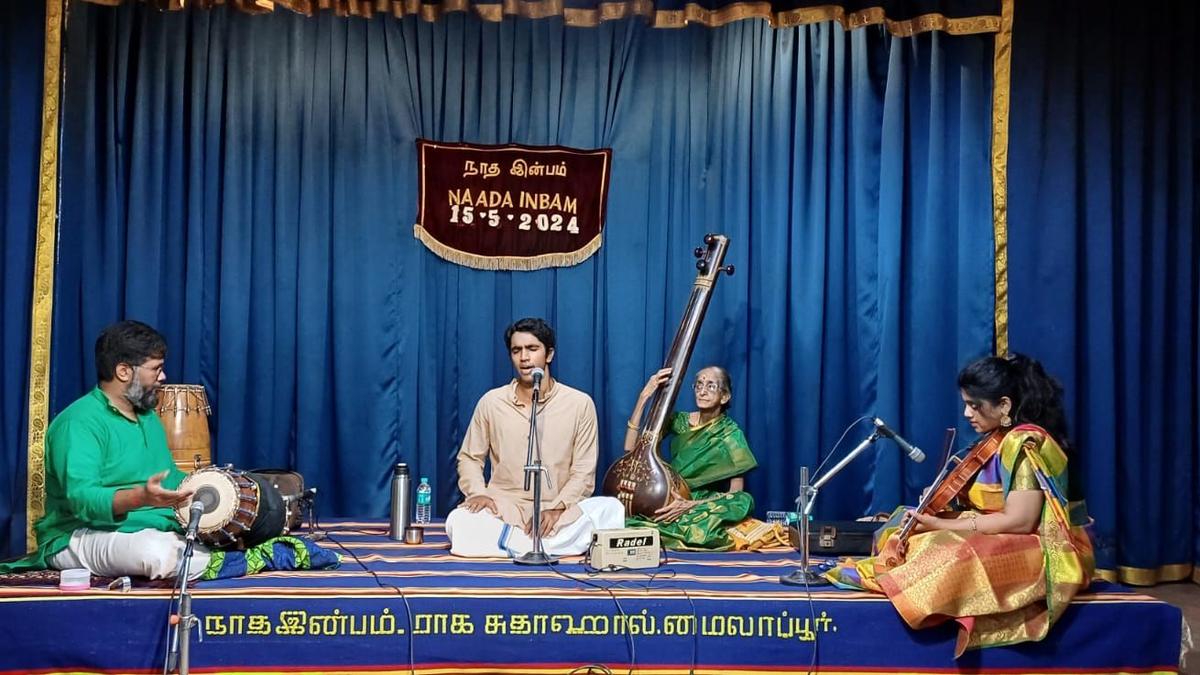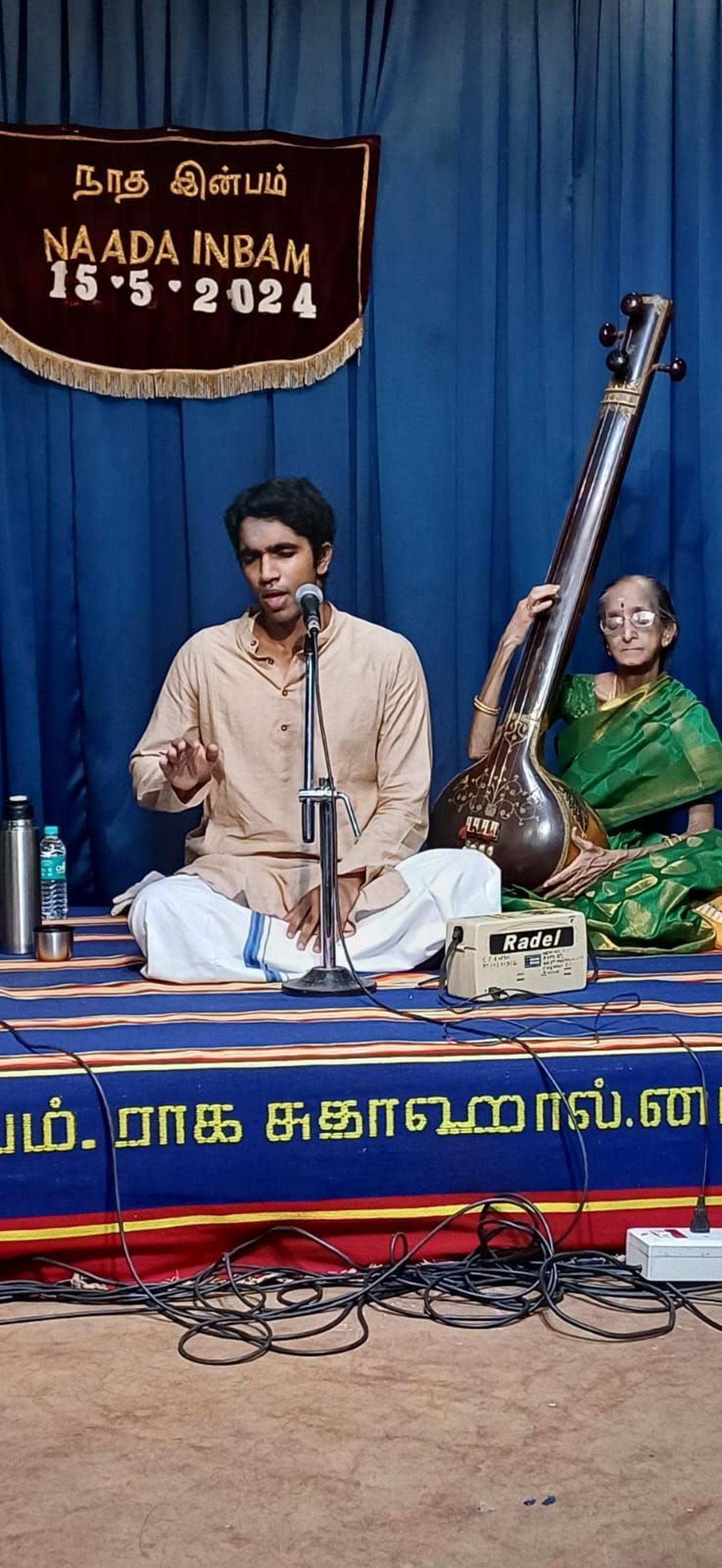- May 21, 2024
On a musical trip to Madurai, Rameswaram and Thanjavur

Vikram rendering his concert themed on three kshetras – Madurai, Rameshwaram and Thanjavur. He is accompanied by Sraddha Ravindran on the violin and Akshay Ram on the mridangam.
| Photo Credit: Courtesy: Naada Inbam
Naada Inbam’s Kshetra Sankirthana Vaibhavam series was an exciting musical journey through the temple towns of Tamil Nadu. The thematic concerts were by young artistes. P. Vikram led a trip to Madurai, Rameswaram and Thanjavur through his singing of kritis attributed to these towns.
The tall, majestic towers of the Sri Meenakshi Sundareswarar temple dominate the skyline of Madurai. Much of the business and life in the city revolves around the temple and its festivals, including the Thirukalyanam [celestial wedding] during the Chithirai Brahmotsavam, the Navarathri festival held during September-October and Masi Mandala Utsavam during February-March.
The temple, dedicated to Meenakshi and Sundareswarar, finds mention in Sangam literature. The huge complex spread over 14 acres, has 14 colourful gopurams, a thousand-pillared hall, a hundred-pillared hall, the Portramarai kulam (golden lotus pond), and the Kambatthadi mandapam, which is famous for depicting all the 25 forms of Shiva.

P. Vikram chose Madurai, Rameshwaram and Thanjavur for his thematic concert series.
| Photo Credit:
Courtesy: Naada Inbam
Of the nine songs that Vikram rendered, six were on Madurai. The piece de resistance was Syama Sastri’s ‘Sarojadala netri’ on Meenakshi. His alapana of Sankarabharanam, a sampurna raga, brought out the grandeur and melody of this sarva gamaka rakti raga. Vikram is the son and disciple of vainika-gayaka, S.P. Ramh. Vikram’s musical assets include a voice capable of negotiating tristhayi with ease, his inventiveness in raga elucidation, and his expressive potential.
The niraval and swaraprastara were at ‘Samagana vinodini’. On the violin, Shraddha Ravindran, who is presently undergoing advanced training under violin virtuoso A. Kanyakumari, rose to the occasion and offered effective response in the alapana, niraval and kalpanaswara segments. On the mridangam, Akshay Ram presented a thani that had aesthetically vast dimensions in rhythm. The Khanda nadai that he elaborated had a reposeful gait.
Vikram commenced his concert with the awesome Navarasa varnam by Lalgudi Jayaraman, ‘Angayarkkanni’. This ragamalika varnam consists of Bilahari, Husseni, Valachi, Saranga, Sucharitra, Atana, Rasikapriya, Sahana and Nadanamakriya. Syama Sastri’s Anandabhairavi kriti, succeeding an eloquent alapana with swaras at the pallavi was a nice rendition. Another Lalgudi Jayaraman composition that Vikram sang was ‘Thenmadurai vaazh annaiye’ in Hamsarupini, with a lilting chittaswara. This raga is a janyam of Harikamboji. Another song that Vikram offered on Meenakshi was ‘Madhura madhura Meenakshi’ by Swami Dayananda Saraswathi in raga Bageshri. He rendered a ragamalika virutham earlier. The Tiruppugazh in Tilang, ‘Ni thatthuvamaaki’ was on Muruga of Madurai.
One of the largest temples in India, the Brihadeeswara Temple also known as Peruvudaiyar Kovil is in Thanjavur. The temple was built around 1010 AD by King Rajaraja Chola I. One of the main attractions of the temple is the huge Lingam and Nandi. The main temple tower is 216 ft high and the tallest of its kind in the world. The entire structure of the temple is made of stone.
On Thanjavur, Vikram offered two songs. ‘Paranthama yuvathi jayathi’ (Rupakam) by Dikshithar in raga Dharmavati had swaras at pallavi in a pleasant kalapramana. The Thevaram verse ‘Ulagellaam thozhavanthu’ in Manirangu by Karuvur Thevar was on Rajarajeswarar.
The legend behind the Ramanathaswamy Temple at Rameswaram is associated with Rama. It is believed that Rama, after defeating Ravana, wanted to worship Shiva as part of atonement. There are 22 teerthams at this temple.
On Rameswaram, Vikram offered, after an elaborate Pantuvarali alapana, Dikshitar’s ‘Ramanatham bhajeham’ (Rupakam). Niraval and swaras were at the usual ‘Kumara guruguha viditham’.
Sraddha Ravindran’s responses to Dharmavati and Anandabhairavi alapana were excellent. Akshay Ram too enriched the concert.
Thematic concerts call for diligent research and meticulous planning, and Vikram didn’t disappoint.




